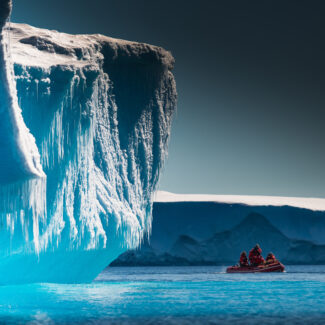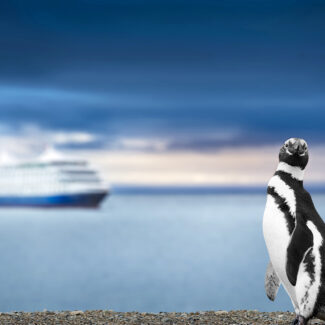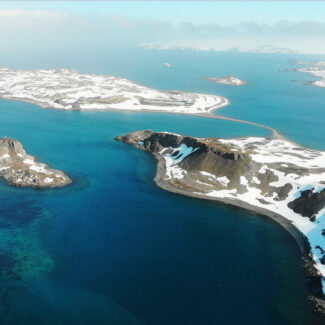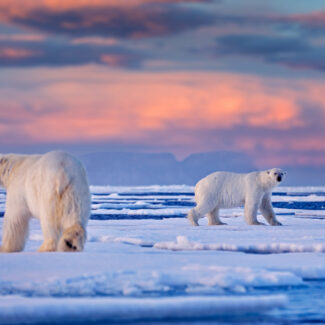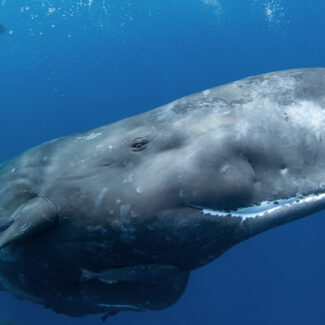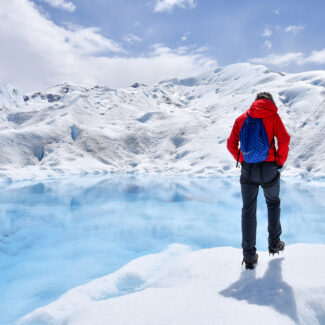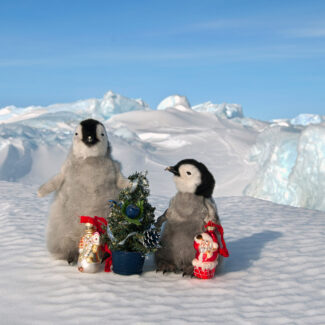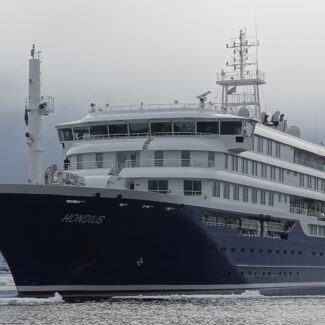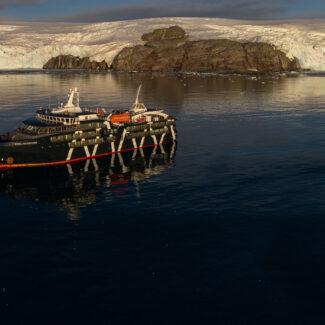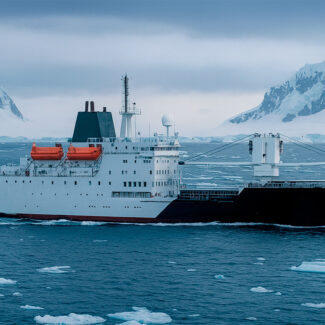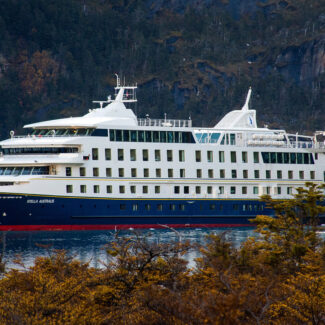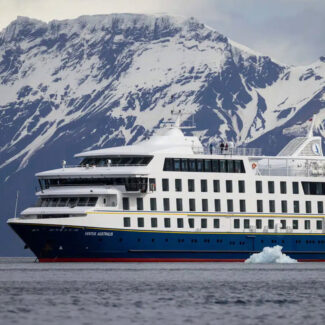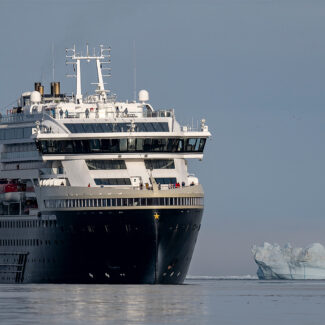The Best Time To See Polar Bears In Svalbard (& The Arctic)
- Factors Determining the Best Time to See Polar Bears in the Wild
- Polar Bear Behavior In The Seasonal Ice Ecoregion
- Polar Bear Behavior In The Divergent Ice Ecoregion
- Polar Bear Behavior In The Convergent Ice & Archipelago Ecoregions
- Peak Cruise Season & Polar Bear Watching
- The Best Time to See Polar Bears in Svalbard
- Best Time to See Polar Bears in Churchill, Manitoba
- Prime Time for Polar-Bear Viewing in Other Corners of the Arctic
Is spotting a polar bear—the world’s heftiest terrestrial carnivore—on your bucket list? It probably ought to be, given the sheer magnificence of the Arctic’s flagship top predator, as well as the uncertain future it faces given our warming climate.
If you are keen to spy an “ice bear,” when should you be scheduling your cruise to the Arctic? In this article, we’ll talk about the best time of year to see polar bears in Greenland, Svalbard, Arctic Canada, Alaska, and other go-to destinations. Keep in mind (or perhaps we should say “bear” in mind) that sightings of polar bears are never a guarantee, but just the opportunity to have one—within the beautiful vastness of their wilderness kingdom—is a thrill.
Timing is everything for a chance to witness these magnificent creatures in their element! Factors like ice conditions and daylight hours significantly influence when and where polar bears can be observed in the wild.
Factors Determining the Best Time to See Polar Bears in the Wild
There are numerous variables that affect when and where you’ve got the best chance of spying the Arctic’s awe-inspiring ice bear. Some of the most fundamental, unsurprisingly, have to do with the bears themselves: their seasonal activities and movements.
These differ somewhat across the four sea-ice ecoregions inhabited by the species (and first defined in the late 2000s by Polar Bear International’s chief scientist, Steven Almstrup)—the Seasonal Ice, Divergent Ice, Convergent Ice, and Archipelago ecoregions:
Polar Bear Behavior In The Seasonal Ice Ecoregion
In the Seasonal Ice Ecoregion, which covers much of central and southern Canada (including Hudson Bay) as well as western Greenland, sea ice is of the annual variety and melts away each summer. That leaves polar bears stranded onshore, where they largely fast and rest until annual sea ice builds back up in the fall—except for pregnant female bears, which head into dens when the other bears take to the ice. Those mother bears thus end up fasting much longer, living off and nourishing their cubs with their fat reserves until they emerge in the spring and can hunt again on the ice.
Polar Bear Behavior In The Divergent Ice Ecoregion
Farther west, from the northern coast of Alaska to Svalbard and the Barents Sea, the Divergent Ice Ecoregion sees ocean currents shuttle coastal sea ice out into the Polar Basin. During much of the year, that coastal ice is being continually replenished, but its production wanes as summer sets in, and therefore an open seawater channel forms between the ice-free coastline and the sea-ice front offshore. Historically, this open-water gap was relatively narrow and polar bears could hunt seals along the ice front over productive waters.
Increasingly, though, the summer gap between the coasts and the sea ice in the Divergent Ice Ecoregion has broadened, and polar bears are increasingly either spending the warmer months onshore, much as their counterparts in the Seasonal Ice Ecoregion, or drifting farther north with the sea ice, which now often lies over less-productive deep waters of the Polar Basin, with limiting hunting opportunities.
In both locations, therefore, Divergent Ice Ecoregion polar bears are often intaking less food and enduring fasting periods (or exploiting different coastal/onshore food resources than their preferred prey of ringed seals). As with the Seasonal Ice Ecoregion, the survival of polar bears in many parts of the Divergent Ice Ecoregion may hinge on how much weight they can pack on during a seasonal on-the-ice hunting season.
Observe these magnificent bears navigating the dynamic divergent ice – a crucial hunting ground where seals surface at leads and polynyas. Their movements are intrinsically linked to the ever-shifting patterns of this environment.
Polar Bear Behavior In The Convergent Ice & Archipelago Ecoregions
The same polar ocean circulation that draws sea ice away from the coastline in the Divergent Ice Ecoregion drives it toward shore in the Convergent Ice Ecoregion, which encompasses the northern Beaufort Sea, the far northern Canadian Arctic Archipelago, and East Greenland. Polar bears here have access to sea ice and good hunting throughout the year.
A similar story prevails in the Archipelago Ecoregion, located among the convoluted seaways within the heart of the Arctic Archipelago; sea ice here also still typically holds through the summer. (The Archipelago Ecosystem and parts of the Convergent Ice Ecoregion are therefore projected to be potential last refuges for the polar bears if current climate-warming trends continue and the Seasonal Ice and Divergent Ice ecoregions become inhospitable for the ursids.)
While Svalbard’s sea ice is crucial, this heartwarming scene hints at denning behavior sometimes observed in archipelago ecoregions. Witnessing a mother and cubs highlights the adaptability of these bears to varying Arctic terrains.
Peak Cruise Season & Polar Bear Watching
Consider those yearly patterns of regional polar-bear distribution and behavior with the logistics of Arctic travel. Peak season for cruising the Arctic is, surprise suprise, the summer, which corresponds with the long days of the Midnight Sun, friendlier temperatures, and more extensive navigable waters and more accessible coastlines. Shoulder-season tourism goes down in the fall and, to a lesser extent, the spring.
Travelers hoping to see a polar bear in the Seasonal Ice Ecoregion often have their best opportunities in early fall, when large numbers of bears may congregate along coastlines to await the imminent return of the sea ice. Those venturing to places in the Divergent Ice Ecoregion during the Arctic summer, meanwhile, may need to cruise farther north to reach the sea-ice front—or journey to those places, such as Svalbard and parts of the Alaskan North Slope, where polar bears seek alternative food sources along coastlines.
And in the Archipelago and Convergent Ice ecoregions, meanwhile, polar-bear viewing is typically possible year-round, though of course sightings are never guaranteed. After all, polar bears hunting the sea ice cover vast distances and can therefore be thinly distributed.
Imagine the thrill of spotting a majestic polar bear like this during your Arctic cruise! The peak season offers incredible opportunities for wildlife encounters amidst stunning icy scenery.
The Best Time to See Polar Bears in Svalbard
Although it’s part of the Divergent Ice Ecoregion, and sea ice is diminishing here faster than anywhere else in the Arctic, the Norwegian archipelago of Svalbard is inhabited by polar bears throughout the year. As we discussed in our article about the best places to see polar bears in the world, Svalbard hosts two different subgroups or lifeways of polar bears: coastal and pelagic bears. In the summer, while most Svalbard polar bears—the pelagic ones—follow the retreating sea ice north and northeastward away from the archipelago, the coastal bears—about 300 or so in number—hang back, inhabiting small home ranges along the seacoast and up fjords, hunting seals when and where possible on glacial icebergs and otherwise subsisting on such foods as bird eggs (and birds).
The best time to see polar bears in Svalbard? May through September, mainly because this is when the archipelago is most accessible to tourism. The specific timetable of summer sea-ice retreat varies from year to year, so depending on when you visit in the summer there may still be quite a lot of sea ice along or close to the coastline, with opportunities to see polar bears traveling and hunting over it. As summer progresses, Svalbard cruises may travel farther offshore for wildlife-viewing along the retreating ice front, while opportunities to see the “local” coastal bears on the islands themselves continue throughout the season.
Svalbard is a major epicenter of denning for polar bears, so you might luck out with a view of a sow and her cubs on a spring or summer visit.
Imagine witnessing this Arctic encounter under the magical light of Svalbard’s extended twilight! The late summer and early autumn offer prime opportunities to observe polar bears as they roam the ice-free coasts.
Best Time to See Polar Bears in Churchill, Manitoba
The “Polar Bear Capital of the World,” Churchill sits on Hudson Bay in the Seasonal Ice Ecoregion, and offers internationally renowned opportunities to view polar bears waiting out the ice-free stretch onshore in the summer and fall. Fattened on seal blubber from hunting season on the now-retreated sea ice, the bears then are mostly fasting on the tundra and stunted taiga of the Hudson Plains, waiting for freeze-up.
Polar-bear viewing opportunities peak in October and November, when most bears congregate along the coast in anticipation of the ice’s return. From tundra buggies to aerial tours, guided bear-viewing is big business in Churchill this time of year.
While Churchill is famous for its autumn polar bear gatherings, seeing these magnificent creatures in their summer habitat amongst the tundra’s colors offers a different, equally captivating Arctic experience.
Prime Time for Polar-Bear Viewing in Other Corners of the Arctic
Although Churchill is the best-known and most consistent place to spot ice bears in Canada, the country lays claim to half or more of the global population of the species, and other parts of its enormous Arctic realm can certainly yield sightings. Indeed, the Canadian Arctic Archipelago is year-round polar bear country. Sightseeing cruises through the Canadian High Arctic, covering the Archipelago Ecoregion as well as part of the Convergent Ice Ecoregion, take you through some of the most (relatively) secure polar-bear habitat on Earth and may, if you’re lucky, give you a firsthand view of one of these mighty and magnificent beasts.
East Greenland is another great polar-bear stronghold. Polar bears can be seen here year-round, but for your average traveler the most convenient and accessible way to visit is on a summertime cruise; tours ply the coast of enormous Northeast Greenland National Park; where lucky cruisegoers may spot a polar bear on the go.
The North Slope of Alaska also offers polar-bear viewing opportunities, most famously on Barter Island, within the Arctic National Wildlife Refuge and host to the Inupiat village of Kaktovik. During the ice-free stretch from August to October, polar bears commonly hang out on regional barrier islands, and the carcasses of bowhead whales legally harvested by Kaktovik hunters often draw scavenging bears to the vicinity of town. An increasing number of tourists are making the journey to this remote outpost during that summer-to-early-fall window, with September being perhaps the best time to see polar bears in Kaktovik.
Beyond Svalbard, the Arctic offers other incredible windows into the world of polar bears! Witnessing a majestic bear like this one navigating the sea ice is a breathtaking experience, often best timed with specific seasonal shifts in different regions.
Disclaimer
Our travel guides are for informational purposes only. While we aim to provide accurate and up-to-date information, Antarctica Cruises makes no representations as to the accuracy or completeness of any information in our guides or found by following any link on this site.
Antarctica Cruises cannot and will not accept responsibility for any omissions or inaccuracies, or for any consequences arising therefrom, including any losses, injuries, or damages resulting from the display or use of this information.



